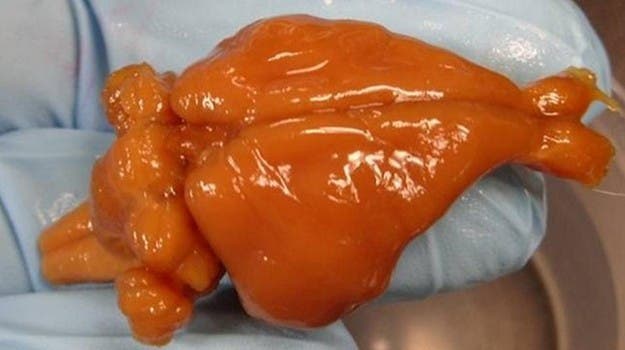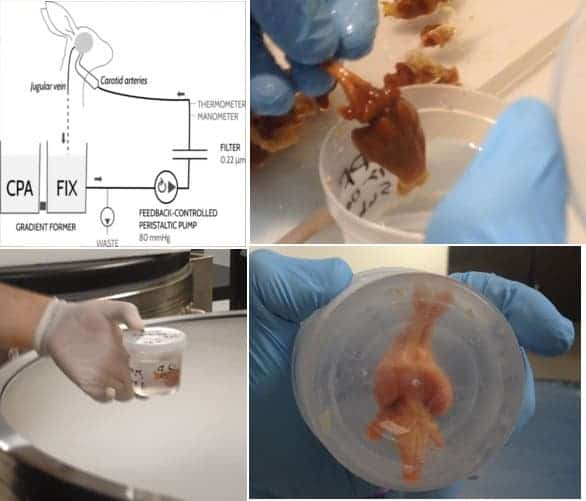Today, some people are freezing their bodies or heads at death in hopes of future cures for what ails them. Alas, these people are likely gone forever because the damage to the brain is far too critical. With this in mind, despite an enthusiastic decade in the ’80s for cryonics, the field has been rarely touched by serious scientists. A group of researchers may spark interest again after they report freezing rabbit and pig brains, then returning them from preservation apparently in mint condition as if they were never iced. This lends hope that just maybe it would be possible to do the same for human brains just before the person dies, and thaw it in proper working condition when the tech is there to revive them.

In the ’60s, Robert Ettinger, then a physics lecturer at Wayne State University in Michigan, published a book called The Prospect Of Immortality. In the book, he outlined the idea of cryonics and launched an international movement. This seemingly SciFi oddity was introduced into reality once with the foundation of the Cryonics Institute. It is here that Ettinger and colleagues would purse their life’s work: that of attaining immortality. The first person to be frozen at the institute was Ettinger’s own mother. More than a hundred patients followed, including Robert Ettinger himself once he passed away in 2011.
To preserve a body, you don’t just throw it on ice just like that, otherwise everything would be ruined. Our bodies are largely made of water, and all these water molecules crystallize, the ice punctures cells. At the Cryonics Institute and elsewhere, the process is as follows: 1) as soon after death as possible, the patient’s body is slowly cooled over five-days until it reaches the temperature of liquid nitrogen (-200C); 2) to preserve the cells, the blood is replaced with a cryoprotectant fluid which prevents the ice crystals from forming 3) the body is immersed in liquid nitrogen and stored upside down, so in case of any leakage the limbs are affects, not the brain 4) finally, the bodies are covered in a sort of ‘sleeping bag’ to insulate them from the risk of sudden warming once these are placed in the cryostats.

Many biological specimens have been cryopreserved, stored at liquid nitrogen temperature where all decay ceases, and revived; these include whole insects, vinegar eels, many types of human tissue including brain tissue, human embryos which have later grown into healthy children, and a few small mammalian organs. Increasingly more cells, organs and tissues are being reversibly cryopreserved.
The problem with complex organisms like mammals, though, is that these technique causes the brain to dehydrate and shrink, causing damage to the connections between neurons. Most certainly, these brains can’t revived, let alone the memories.
Researchers from 21st Century Medicine (21CM) might have a better way. They invented a new technique called Aldehyde-stabilized cryopreservation (ASC) in which the brain’s vascular system is filled with chemicals that would allow it to be cooled to -211 degrees Fahrenheit (-135 degrees Celsius). Afterwards, when the cryonic rabbit and pig brains were thawed “preservation was uniformly excellent: processes were easily traceable and synapses were crisp in both species,” the researchers note in the journal Cryobiology.
“ASC has many advantages over other brain-banking techniques: chemicals are delivered via perfusion, which enables easy scaling to brains of any size; vitrification ensures that the ultrastructure of the brain will not degrade even over very long storage times; and the cryoprotectant can be removed, yielding a perfusable aldehyde-preserved brain which is suitable for a wide variety of brain assays,” they write in the paper.
They added: “ASC promises to be a powerful new technique in the quest of connectomics researchers to unravel the mysteries of the mind. We also hope that ASC will inspire investigators in other fields to consider the possibility of cryobiological solutions to their problems.”
To test the brains integrity, the researchers cut them in slim section and examined them with an electron microscope. The readings show no visible sign of physical damage to the brain cells or connections between them.
The test was carried out only week after the brain were cryogenically frozen, so damage might occur later on. This should be tested, but the research shows that preserving the human brain (the most important component) isn’t entirely impossible. It could spark new interest, and who knows what will come of it.
“There is compelling preliminary evidence from the neuroscience literature that preserving a brain at the ultrastructure level… might also preserve the memories stored in that brain,” the reserachers said. “Now that whole brain preservation is a scientific reality, we look forward to a lively scientific debate over the exact level of preservation necessary to preserve memory.”


